Largest hoard of hammered gold coins ever found
On 22 March 1966, at Fishpool, which is situated close to Newstead Abbey in Nottinghamshire, the largest and most important hoard of English, Scottish and foreign hammered gold coins (1,237 in total) ever discovered in Britain was unearthed. The illustrations accompanying this article include a large group of coins from the hoard, together with several pieces of jewellery.
George Gordon Byron
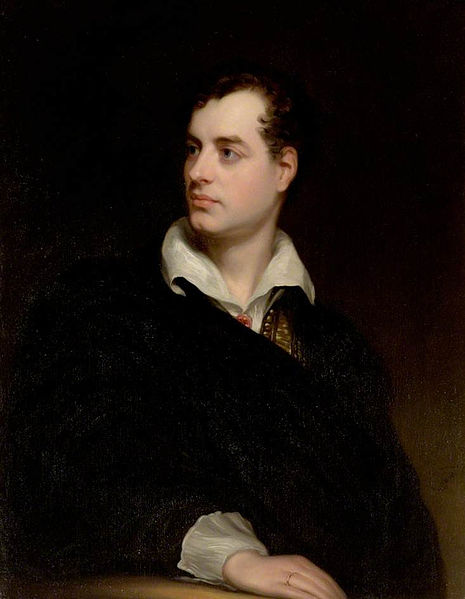
Lord Byron
Painting by Thomas Phillips, 1813
Newstead Abbey was the family seat of the Byron family. George Gordon Byron, who gained fame as a poet and womaniser, became Lord Byron in 1798. He had not been directly in line for the title but inherited it because his father had died in 1791 and the fifth baron’s grandson was killed in 1794.
A number of women were involved with Byron, the best-known being Lady Caroline Lamb, who said he was “Mad, bad and dangerous to know.” Deeply in debt, Byron tried to sell off the family seat a number of times; one potential buyer paid a deposit of £5,000 and ended up losing it because he couldn’t raise the rest of the purchase price. In 1816 Byron left England and never returned.
Newstead Abbey was eventually sold for £94,000 in 1818. On 19 April 1824 Byron died in Greece, a country of which he was exceedingly fond. The details about Lord Byron and Newstead Abbey might seem irrelevant but the reason I have included them will become clear later on.
Discovery of the hoard
Press reports
On 25 March 1966 The Times published an account of the initial discovery of the Fishpool hoard. It also appeared in the May 1966 issue of Seaby’s Coin and Medal Bulletin. The report in the latter was the first I heard about the hoard, as I had missed the notice in The Times. A hoard of about 1,000 ancient gold coins had been found on a building site near Newstead Abbey, Nottinghamshire. The coins had been handed over to the police at Mansfield. The hoard was to be sent to the British Museum for examination and cataloguing. A museum curator said he would not argue with a tentative value of £30,000. The site developers said the coins bore traces of having been enclosed in a canvas or leather bag, which had rotted away.
Unearthed by an excavating machine
For those involved in the recovery of this spectacular hoard the day would have started much like any other. There were four workmen and a lorry driver on the site. Also present was a small boy, aged five, who lived nearby. One of the workmen was operating an excavating machine. He said coins were first sighted when the mechanical shovel scooped up a group of them. From this account, it is impossible to say if the shovel hit upon the hoard just below the surface or in a trench. Imagine the scene: piles of large and shiny gold coins suddenly appear out of the blue! The job in hand must have been forgotten as the four workmen and the lorry driver started to pick up coins and jewellery. The small boy, too, joined in and managed to get hold of four coins.
The finders
The four workmen were John Craughwell (the excavating machine driver), James Flint, Alfred Martin and Michael Blythe. The lorry driver was Bernard Beeton and the small boy David Welham. In 1966 the old law of Treasure Trove was in place. An inquest would be needed to establish whether the hoard had been lost or purposely hidden.
Coins sold to a dealer
A mystery man
Prior to the inquest, in May of 1966, a man calling himself Hewlitt Cosgrove Thompson walked into a coin dealer’s shop in London with three gold nobles. Thompson said the coins were part of his grandfather’s collection and the dealer paid him £500 for the group. This dealer (Dealer A) sold them to Dealer B for £625. This wasn’t big profit in percentage terms but £125 was a lot of money in 1966.
In June Thompson sold four more nobles to Dealer A for £1,500. On this occasion Thompson said he had an Edward IV noble; this was a great rarity, for at the time only four specimens were known. On the next visit Thompson was paid £7,330 for a number of gold coins, one of which was an Edward IV noble. In July Dealer A bought more coins for £14,280 in cash. Two of which were sold to Dealer B for £12,750. In all, Dealer A had bought coins for a total of £23,610.
Suspicions aroused
By now Dealer B was becoming suspicious about all the hammered gold coins coming from Dealer A. Dealer B, a director of the company on whose behalf he had bought the coins, is quoted as saying: “I contacted the British Museum authorities before I had learned of the finding of the hoard at Fishpool. I only learned of the hoard as a result of my inquiries at the British Museum. I established beyond doubt that these coins belonged to this find. As a result I handed them over shortly afterwards to the British Museum.”
Hewlitt Cosgrove Thompson was never traced, so his exact identity remains a mystery. However, somehow or other he had access to coins from the Fishpool hoard. Had his identity been established he could have been prosecuted.
Treasure Trove inquest
The inquest into the hoard was held on 14 and 15 December 1966. Most of what follows is taken from pieces published in The Times. These were included in the February 1967 issue of the Numismatic Circular. There are also extracts from the Nottingham Evening Post, which were featured in the February 1967 issue of Seaby’s Coin and Medal Bulletin.
Coroner’s instruction to the jury
The coroner told the jury that about 1,200 coins had been found at Fishpool. He went on to say: “If you establish that it is Treasure Trove you will have to decide whether the find was properly disclosed to me through my officials in such a manner that in no circumstances the finders could be deemed to have concealed any part of it. If you determine it is Treasure Trove and there was concealment, the right to receive any reward from her Majesty’s Treasury will be lost.”
Craughwell and Flint admit to hiding coins and jewellery
At the inquest, John Craughwell and James Flint both admitted that they tried to hide part of the hoard from the police. In an office on the building site, the day after the discovery, Mr Craughwell handed over some coins and jewellery to a PC Taylor. He told the officer he had found one gold chain, one gold locket, one gold ring and 244 coins. However, only 190 coins were revealed. In August he amended his statement and said he had found 279 coins and kept 35 of them. He later admitted to finding 285 coins. He said he hid some of them behind a skirting board at his home.
On 24 March and 20 August 1966, James Flint made statements saying he had found 325 coins, a ring and a brooch. On 25 August he admitted that he had found 354 coins. He said that he had handed over 348 to PC Taylor and kept six, which he buried in his garden. He is reported as saying: “We always felt like telling the truth but we were frightened of what might happen.”
Coroner’s summing up
In his summing up, the coroner described Mr Craughwell as a “self confessed liar”. Of Mr Flint, he said: “He had the chance to come clean earlier, but did not take it”. The coroner added that the conduct of Mr Blythe and Mr Martin was just the same. He suggested that the four of them might have “got together to cook the goose” for PC Taylor.
At the previous day’s hearing PC Taylor was alleged to have short-counted the coins handed in by Mr Craughwell. The constable had been suspended during police investigations into the find and later temporarily reinstated pending a decision by the Director of Public Prosecutions. The coroner praised PC Taylor for coming to the inquest to face the challenge of cross-examination. He was described by the coroner as “a lowly policeman”, whose word was entitled to be believed just the same as anyone else’s.
The inquest jury decided that the find was Treasure Trove and the property of the Crown. They ruled that only two of the six finders – Bernard Beeton and the boy, David Welham – should be rewarded. The others had concealed some of the items they had found. In doing so their right to a reward was forfeited.
Content of the hoard

Fishpool Hoard
Photo: Andy Flatman, CC BY 2.0
The hoard was made up of 27 coins of Edward III, 12 of Richard II, 38 of Henry IV, 266 of Henry V, 606 of Henry VI, 63 of Edward IV, 33 Anglo-Gallic coins, 13 Scottish, 11 French, 166 Burgundian and two forgeries of Henry IV.
The hoard is on display at the British Museum.
Accompanying the coins were a number of pieces of gold jewellery: a heart-shaped enamelled brooch, an amethyst-set pendant cross, a sapphire-set roundel, a padlock, four finger rings and a quantity of gold chain. All the items are in wonderful condition and of superb quality.
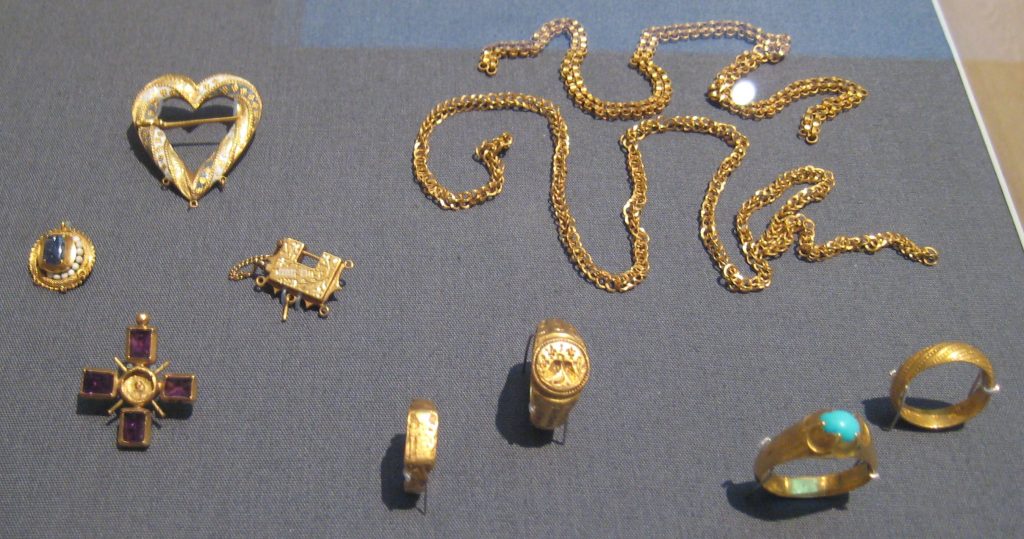
Photo: CC 0 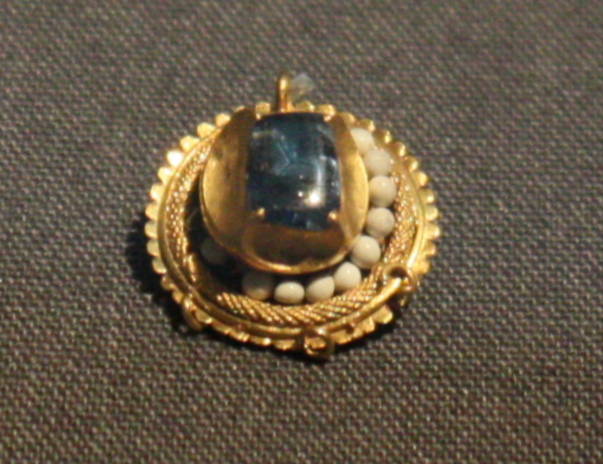
Photo: CC BY 2.0 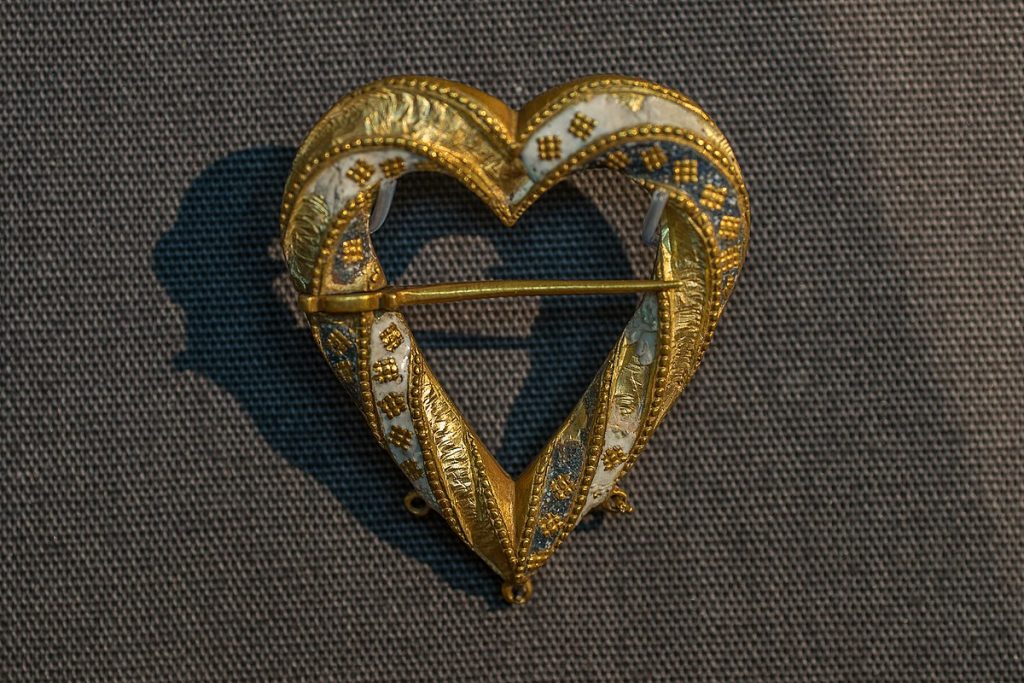
Photo: Paul Hudson CC By 2.0
As could be expected with a hammered gold hoard of this exceptional size, it included quite a number of rarities and a few coins that were previously unknown. The latter included a Henry VI leaf mascle coinage half noble, a Henry VI cross pellet coinage noble, and an Edward IV heavy coinage quarter noble.
The most amazing element of the hoard, though, was the inclusion of no less than 62 heavy coinage nobles of Edward IV. Prior to the discovery of the Fishpool hoard only four examples were known. Now those four were joined by another 62! Included amongst these coins were several new varieties. As these were the ‘newest’ coins when the hoard was deposited in the soil, most of them were in close to mint condition.
Who originally owned the coins and jewellery?
The identity of the original owner of what has come to be known as the ‘Fishpool hoard’ must remain a mystery. What we can be sure of, though, is that it must have been someone of high status. It has been estimated that the content of the hoard would have a purchasing power of around £400 in the 1460s. At the time this would be an enormous sum of money. A sum so great that it would be in the possession of only substantial landowners and a few very wealthy merchants.
Deposited by someone fleeing a battle?
Henry VI had been deposed in 1461 and replaced by Edward IV; after a good deal of turmoil a member of the Lancastrian dynasty was replaced by a member of the House of York. Ordinary people rejoiced, as they hoped this would bring an end to the arguments between the Lancastrians and Yorkists. Their hopes were in vain, as several more fallouts would occur during the following years.
In 1464, the Earl of Warwick was conducting mopping up operations in the north on behalf of Edward IV. In May a decisive battle was fought and won at Hexham (Northumberland). After this, Warwick’s brother, John, became Earl of Northumberland. For a few years, the spilling of blood ceased.
The latest coins in the Fishpool find (the Edward IV nobles) point towards the hoard being deposited during 1464. The only major battle fought in that year was the battle at Hexham. This is a long distance away from the find spot. Hoards are usually deposited in the soil at times of strife. However, the area around Fishpool seems to have been free from conflict in 1464. Therefore, not only is the original ownership a mystery but so too is the reason why such a huge cache of gold was placed in the ground. Only of one thing can we be certain: whoever buried this store of wealth did not live long enough to return and unearth it.
Differing outcomes for the Finders
Bernard Beeton
Mr Bernard Beeton was described by the coroner as “an honest little chap”. He had found 100 coins, all of which were handed over to the police. Out of these 100 coins, 85 were returned to Mr Beeton. The other 15 were retained for the British Museum and local museums. For the whole group Mr Beeton received £1,485, which was reported as being “the full market value”. To the best of my knowledge, the identity of these coins has never been published.
David Welham
The four coins found by the small boy, David Welham, were returned to him; the group was made up of nobles of Henry IV, V and VI and a lion d’or of Philip the Good of Brabant. The coins were sold as a group to a leading London coin dealer for £1,075. It’ a pity the lad wasn’t playing on the building site with some of his pals. Had that been the case then other small boys might have managed to grasp a handful of late medieval gold coins.
Auction of Mr Beeton’s coins
On 17 October 1968 Glendining & Co. offered for sale at auction the 85 coins returned to Mr Beeton. The auction was made up of two nobles of Edward III, three nobles of Richard II, four nobles of Henry IV, 24 nobles and one half noble of Henry V, 34 nobles and three half nobles of Henry VI, two Scottish lions, two Anglo-Gallic salutes, and four coins of Philip the Good, Duke of Burgundy. The star lots were numbered 72 to 77 in the sale catalogue. They were six Edward IV heavy coinage gold nobles.
How would the large find affect prices
Prior to the Glendining auction potential buyers might have been wondering how the market would react to a high number of hammered gold coins going under the hammer. Would prices hold up? Or, might they drop from the current level? The largest group in the sale was made up of 34 nobles of Henry VI. These included several coins of the not particularly scarce annulet coinage; the 1968 catalogue price for the latter was £47.50 in Fine condition.
Day of the auction
The saleroom was packed when at 1.00 o’clock the auction commenced. Catalogue prices were ignored as the bidding got under way. Most of the Henry VI annulet nobles were in VF or better condition; only one was graded as Fine and that was knocked down for £120. The VF coins averaged a little over £200 each and EF specimens £360. This sounds cheap today but it certainly wasn’t back in 1968. Everyone had been wondering what price the Edward IV nobles would bring. The first two, about EF and EF, realised £4,400 and £4,200, which were really high prices for the time. However, the last four did much better, the hammer prices being £10,000, £9,600, £10,000 and £10,500.
The 85 lots were sold in well under 85 minutes. No doubt most of the buyers would have been very pleased to have acquired coins from the Fishpool hoard. However, some might have wondered if they had paid too much for the privilege. We can be pretty certain that Mr Beeton would have been pleased, for the grand total for the 85 coins came to £85,000. He would have to pay 12.5% commission to Glendinings but in 1968, had he wanted to, he could have bought two dozen semi detached houses with the proceeds.
Craughwell, Flint, Martin and Blythe
The honest Mr Beeton and young David Welham did well out of the Fishpool hoard. What about the other four finders? At the inquest the jury had ruled that only Beeton and Welham should be rewarded; the other four finders had concealed some of the items they had found. In doing so their right to a reward was forfeited.
Ex gratia awards
On page 353 in the October 1968 issue of Seaby’s Coin and Medal Bulletin there was an update on the Fishpool hoard. After mentioning what happened at the inquest, it said that the four other persons involved were to receive ex-gratia awards of £5,228, £4,172.10s, £2,501 and £244. It did not state which of the men received which amount. The report went on to say: “A very full and careful investigation after the inquest, in the course of which the British Museum heard representations on behalf of these men from their legal advisers, revealed mitigating circumstances in the light of which it seemed inappropriate to make no reward at all. The Trustees of the British Museum, with the consent of the Treasury, have therefore approved awards for these men, on a very much reduced scale.”
Did their conduct merit any reward
Because of their conduct, there would be some who argued that the four men should not receive a penny. Quite what the “mitigating circumstances” were wasn’t stated. They must have been fairly strong to overturn the wishes of the inquest jury. At Glendining’s sale of Mr Beeton’s coins the average price for the six Edward IV nobles worked out at over £8,000 each. There were roughly 1,200 coins in the hoard and let’s say that it included 60 Edward IV nobles; this would average out at five nobles for every 100 coins. Therefore, in terms of the number of Edward IV nobles in his 100 coins, Mr Beeton’s total was slightly above average.
From information gleaned from the inquest, it would seem that Mr Flint found 354 coins and Mr Craughwell found 285; therefore, the two highest figures – £5,228 and £4,172.10s – probably relate to these two men. Averages don’t always work out as one would expect them to, but in the case of this hoard let’s say they might have. If there were five Edward IV nobles in every batch of 100 then 354 should contain no less than 17, and 285 coins should contain at least 14. From these figures we could say that in 1968 the value of the Edward IV nobles in these two batches would amount to £136,000 and £112,000. To these figures could be added the value of all the other coins and any accompanying jewels.
Because of their dishonesty the men were lucky to receive any reward. However, the amounts received pale into insignificance in comparison to the figures they would have been entitled to had they revealed the true extent of their finds at the first opportunity.
Back to Lord Byron
A few years back there was a programme on one of the main TV channels about Lord Byron. It examined his literary work and, as could be expected, it went into some detail about his somewhat dubious private life. For example, the women with whom he had affairs were named; this, of course, is typical of some TV companies, which believe that throwing in a bit of scandal will interest viewers.
Marriage, child and debts
In 1815, after what has been described as a hesitant courtship, he eventually married Annabella Milbanke, the daughter of Lady Melbourne. Through their union a daughter, Augusta Ada, was born. Byron was disappointed, for he had been hoping for a son. A few weeks after Ada (as she came to be known) was born Byron dismissed his wife and daughter from the family seat. He never saw them again. His debts were piling up, doubts were being cast on his sanity, and rumours about his private life were met with horror and condemnation. Thoroughly disillusioned, in 1816 he left England and never returned.
Search for treasure at Newstead Heath
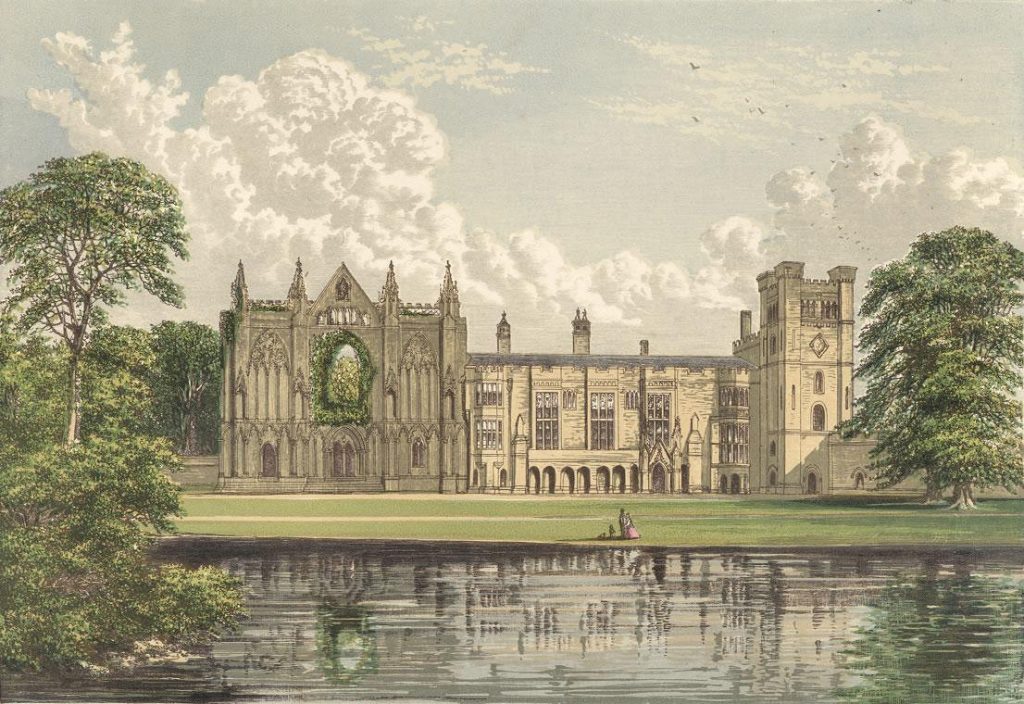
Newstead Abbey
from Morris’s Seats of Nobleman and Gentlemen, 1880
The programme also mentioned the Byron family seat: Newstead Abbey. There was a passing comment that I considered to be particularly intriguing: Byron was said to have thought that at some time in the past treasure had been buried by monks. He instructed his retainers to search for this treasure and in 1814 he called in a builder to dig up the cloisters.
Apparently, there was a family legend, which might have dated back hundreds of years, about a cache of treasure. Could this have related to the hoard that was buried a relatively short distance from Newstead Abbey? Perhaps there was a connection and if Byron’s men had widened their search they could have stumbled upon the treasure discovered by accident in 1966.
How close was Byron to finding the hoard?
Had the producers done a bit more research they could have included details in regard to the Fishpool hoard in the programme about Lord Byron. What better ending could there be than to show the hoard as it is displayed, today, in a large case in the British Museum? Viewers might have been impressed by the information about Byron. I would wager they’d be far more impressed by the sight of a huge circle of medieval gold coins, plus the Fishpool jewellery. Perhaps Lord Byron even walked over the find spot and never realised his feet were very close to a pile of gold, which would have gone a long way towards clearing all his debts.
Tailpiece
Ada Byron
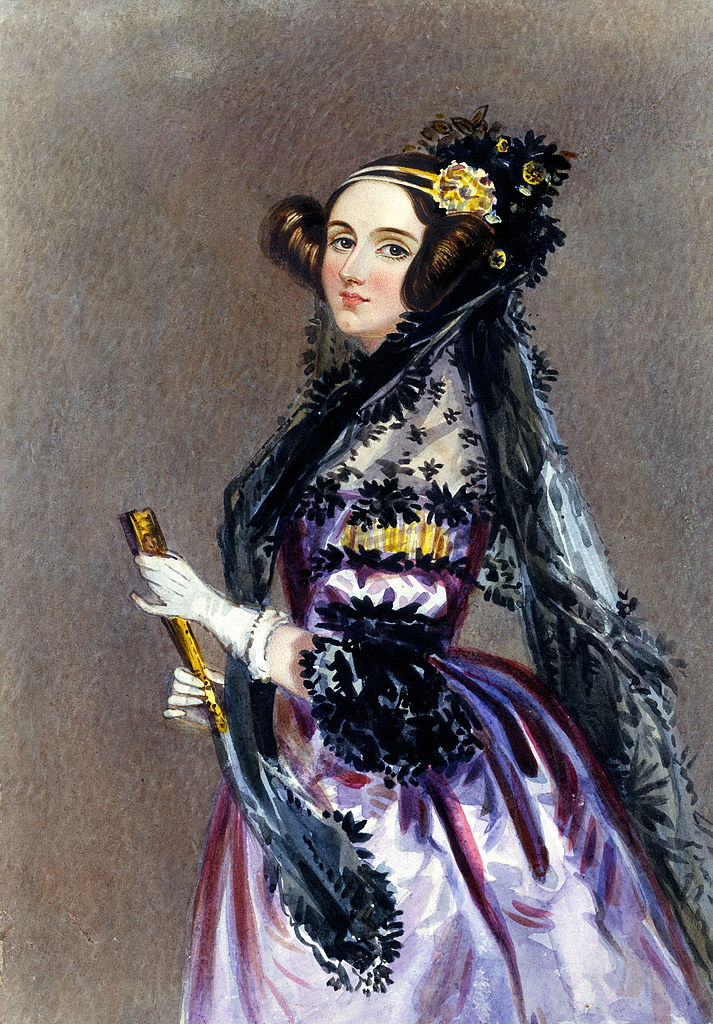
Ada Lovelace
Watercolour by Alfred Edward Chalon around 1840
Byron’s daughter had a sickly childhood but benefitted from a sound education, which was unusual for girls at the time. She was a brilliant mathematician and writer and mixed with many of the leading scientists of the day. She worked closely with Charles Babbage, the inventor of the analytical engine – a massive mechanical device – which was arguably the first computer. However, she is thought to have surpassed Babbage and many consider her to be the first person to have looked into the possibility of computer programming.
In 1838 Ada Byron married William King, who was raised up to be Earl of Lovelace in 1838. Thereafter, until her untimely death in 1856, she was known as Ada Lovelace.

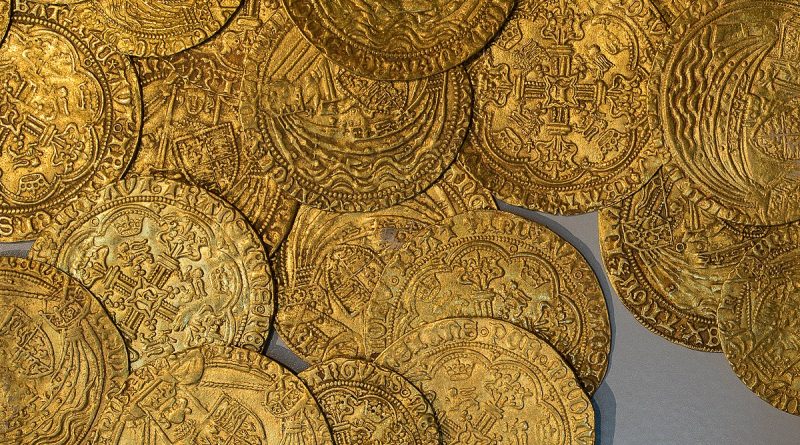
It was my late father John Craughwell who found the Fishpool treasure hoard
Great read, really enjoyed it.